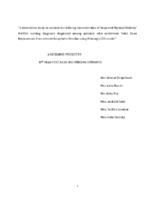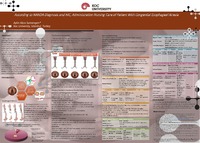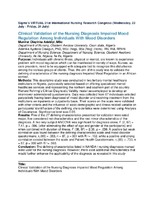| dc.contributor.advisor | Lakhani, Rita | en |
| dc.contributor.advisor | Samudre, Seema | en |
| dc.contributor.author | Bhopalbade, Mrunal | en |
| dc.contributor.author | Bande, Anita | en |
| dc.contributor.author | Roy, Jisha | en |
| dc.contributor.author | Patel, Ayeshabi | en |
| dc.contributor.author | Gaonkar, Suchita | en |
| dc.contributor.author | Wakshe, Anita | en |
| dc.date.accessioned | 2015-10-02T14:37:07Z | |
| dc.date.available | 2015-10-02T14:37:07Z | |
| dc.date.issued | 10/2/2015 | |
| dc.identifier.citation | Bhopalbade, M., Bande, A., Roy, J., Patel, A., Gaonkar, S., & Wakshe, A. (2015). Validating nursing diagnosis: Impaired physical mobility. The Virginia Henderson Global Nursing e-Repository. Retrieved from: http://www.nursinglibrary.org/vhl/handle/10755/579078 | en |
| dc.identifier.uri | http://hdl.handle.net/10755/579078 | en |
| dc.description | <p>This is a research project by 6 second year Post Basic B.Sc. nursing students under the guidance of Professor Rita Lakhani, Principal, Ms. Seema Samudre, Guide, The Fortis Institute of Nursing, Mumbai, India</p> | en |
| dc.description.abstract | <p>Validation studies are important for advancing evidence based nursing practice. In our study, we validated defining characteristics of NANDA nursing diagnosis of Impaired Physical Mobility in Total knee replacement patients. As per previous ROL, impaired physical mobility is one of the most common nursing diagnoses found in TKR patients mainly on first and second postoperative day, because of delayed identification of defining characteristics and improper nursing interventions. The objectives of this study is to validate defining characteristics of impaired physical mobility in TKR patients and to categorize them into major and minor, by using Clinical Diagnostic Validity (CDV) of Fehring model (1986).<br />For this purpose, Non experimental descriptive research design was used. A structured observation checklist was developed by the researchers on basis of modified Likert scale. Two expert nurses were selected based on their education and work experience. The mean of their age was 31.5 and mean of their work experience was 8.The pilot study was conducted on 5 TKR patients in FORTIS HOSPITAL which determined that the tool was unambiguous and practicable. The main study was conducted on patients who underwent TKR surgery having first and second postoperative day in LEVEL 4, 5, 6 of FORTIS HOSPITAL. Data was collected by two expert nurses on observational checklist by observing for presence or absence of defining characteristic. Total 20 samples of TKR patients were observed for their mobility on first and second postoperative day. Expert nurses observed TKR patients for defining characteristics of impaired physical mobility when patients were on bed and when they were mobilized from bed to chair and from chair to ward environment (ward passage) and they were rated by using CDV model –inter rater method.<br />In this study, total male patients were 30% and female patients were 70%.Total 55% of patients were of age 50-59yrs, 30% were in 60 -69 age criteria and 15%were in 70-79years age.35% Patients with co-morbidities like hypertension, diabetes ,seizures, hypothyroidism, etc.10%of patients were having family history of osteoarthritis.70%<br />4<br />patients were undergraduates and 30% were graduates.70%of patients were from middle-class socioeconomic status and 20%were from higher class and 10% were from lower class.<br />Total 12 defining characteristics along with their weighted reliability ratio are as follows: reluctance in attempt to move(1), difficulty in purposefully moving within the physical environment(1), limited range of motion(1), fear of falling(0.95), report of pain(1), gait changes(0.9), postural instability(0.92), slowed movement(1), decreased muscle endurance strength(1), uncoordinated movement(0.76), fear of dislocation of prosthesis(0), decreased reaction time(0.92). Results indicated 10 major (weighted ratio=0.8 and above) and 1 minor (weighted ratio=0.5 to 0.79) defining characteristic and 1 defining characteristic was irrelevant (weighted ratio below 0.5).Total DCV score was 0.87.Early intervention and identification of impaired physical mobility in TKR patient is crucial. As much evidence based research is not available, further refining in this area is needed.<br />CONCLUSION: The aim of the present study was to develop and validate the defining characteristics, operationally defined through ROL for the nursing diagnosis, impaired physical mobility in TKR patients on their first and second postoperative day. The defining characteristics should be assessed in patients with TKR using the selected sample of expert nurses and categorize them into major and minor .We found that total 10 defining characteristics such as reluctance in attempt to move, difficulty in purposefully moving within the physical environment, limited range of motion, fear of falling, report of pain, gait changes, postural instability, slowed movement ,decreased muscle endurance strength, decreased reaction time were characterized as major and uncoordinated movement was classified as minor and fear of dislocation of prosthesis became irrelevant. Total DCV score was 0.87.This evidence will help a nurse in timely identification of defining characteristics and to form accurate nursing diagnosis. This evidence based practice will come in handy for newly recruited staffs and student nurses for practicing nursing process. By using this, more and more nurses will have more confidence in the use of official NANDA nursing diagnosis Impaired Physical Mobility.</p> | en |
| dc.format | Text-based Document | en |
| dc.language.iso | en | en |
| dc.subject | NANDA Diagnosis | en |
| dc.subject | Impaired Physical Mobility | en |
| dc.subject.mesh | Nursing Diagnosis | en |
| dc.title | Validating nursing diagnosis: Impaired physical mobility | en |
| dc.type | Research Study | en |
| dc.rights.holder | <p>
All rights reserved by the author(s) and/or publisher(s) listed in this item record unless relinquished in whole or part by a rights notation or a Creative Commons License present in this item record.
</p><p>
All permission requests should be directed accordingly and not to the Sigma Repository.
</p><p>
All submitting authors or publishers have affirmed that when using material in their work where they do not own copyright, they have obtained permission of the copyright holder prior to submission and the rights holder has been acknowledged as necessary.
</p> | en |
| dc.description.note | <p>Clinical Focus: Adult Medical/Surgical</p> | en |
| thesis.degree.grantor | The Fortis Institute of Nursing, Mumbai | en |
| thesis.degree.level | Post Basic B.Sc. | en |
| thesis.degree.year | 2015 | |
| dc.type.category | Full-text | en |
| dc.evidence.level | Other | en |
| dc.research.approach | Quantitative Research | en |
| dc.subject.cinahl | NANDA Nursing Diagnoses | en |
| dc.subject.cinahl | Impaired Physical Mobility (NANDA) | en |
| dc.contributor.department | Non-member | en |
| dc.description.reviewtype | Peer-review: Single Blind | en |
| dc.description.acquisition | Self-submission | en |





